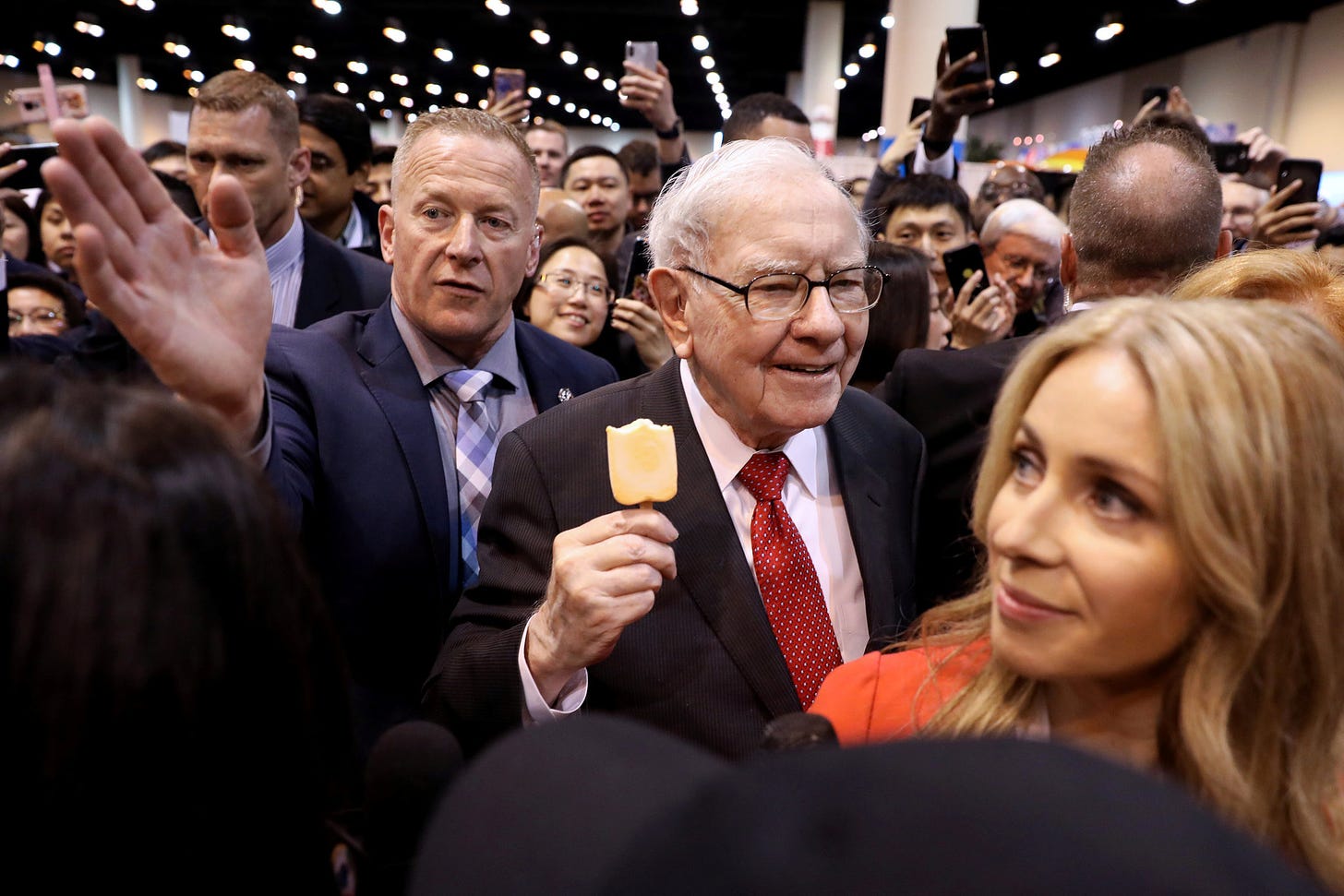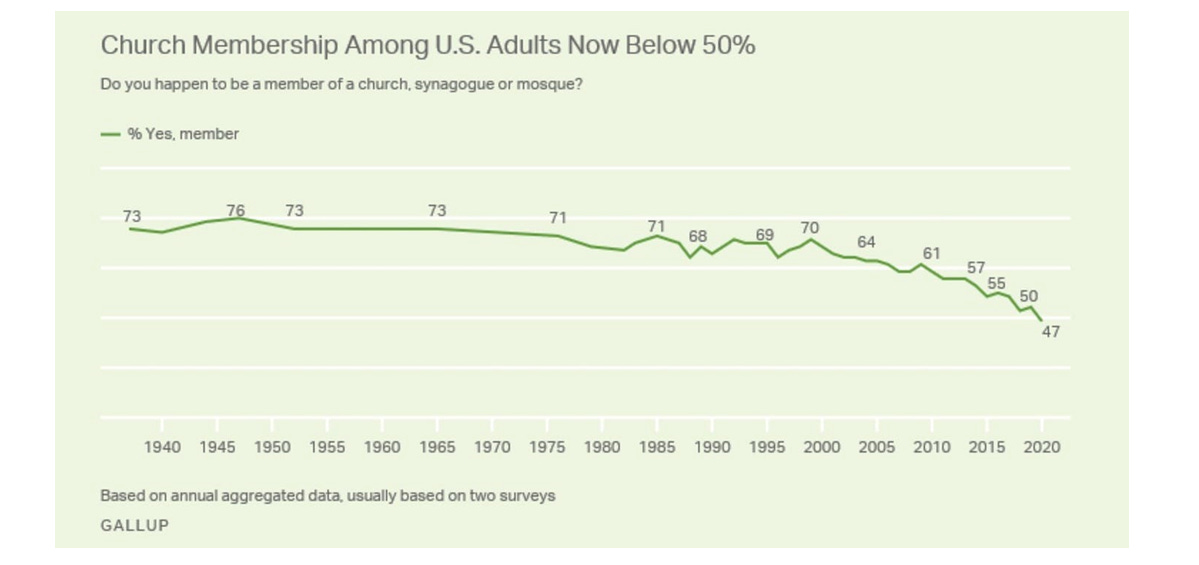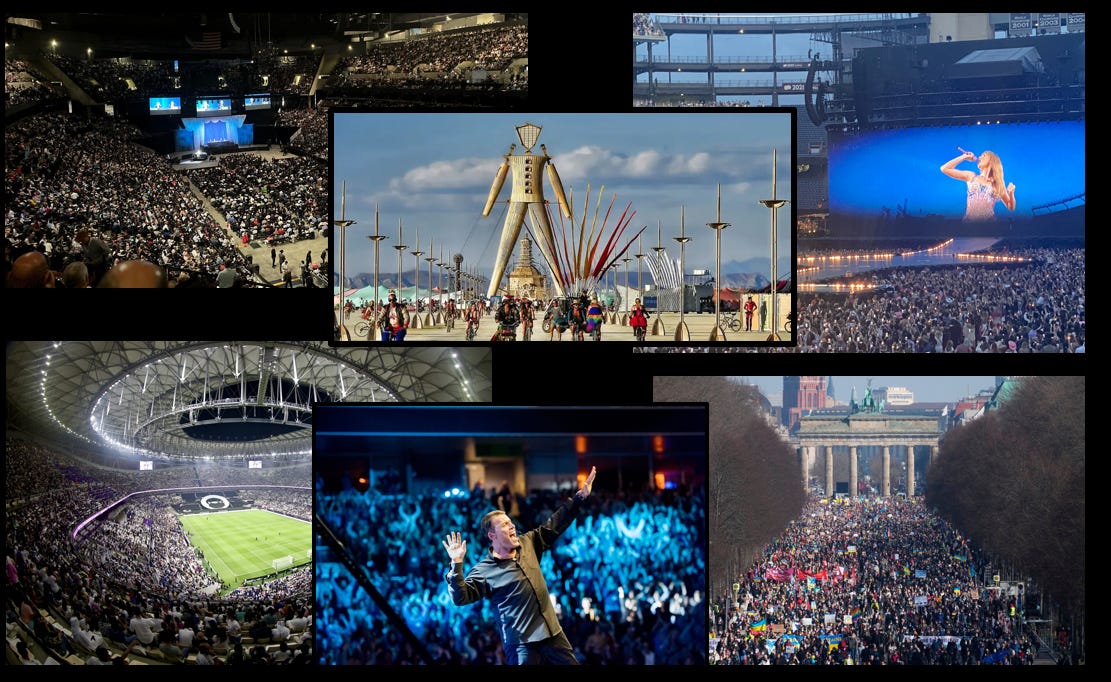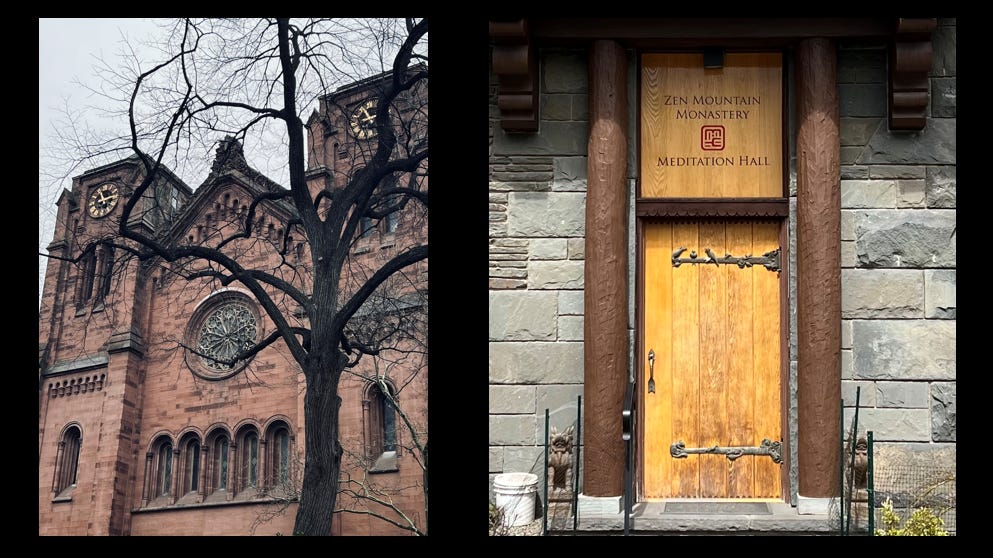How the Search for Secular Cathedrals Is Emptying Our Wallets Without Filling Our Hearts
What Berkshire Hathaway's annual meeting tells us about a world searching for community, wisdom, and meaning.
In 2009, I attended Berkshire Hathaway’s annual meeting which has been compared to a pilgrimage for capitalists and rightly so. For a few days, tens of thousands of visitors descend on Omaha to break bread with their secular sangha. They wait in line to enter a capitalist temple (a so-called convention center) and listen to Warren Buffett (and until recently Charlie Munger, RIP) give a dharma talk filled with wisdom about business and life. I returned home with a signed copy of The Snowball, Buffett’s biography, one of many books of scripture in the lifelong learner’s canon.
You don’t have to venture into spiritual spaces to feel the collective yearning for community, values, and shared rituals. It fuels our obsession with sports, concerts, self-help seminars, and even shows up during college protests (watch the kids get together to dance and chant). In Omaha, even the capitalist hyper-rationalists do it.

Derek Thompson recently wrote about America’s churches emptying which didn’t surprise me one bit. I grew up in Germany, baptized protestant but agnostic from the get-go. Religion felt like old news, an outdated and unnecessary remnant of darker ages. The churches had been emptying for as long as I could remember. It seemed like the US was just catching up with the rest of the secularizing West.
And why wouldn’t the modern, educated, and independent consumer leave behind their society’s antiquated religious institutions?
I can think of a laundry list of issues beyond mere lack of faith — a rejection of institutions that are too rigid, too stale and corrupt, whose language is too antiquated, and whose values may seem outdated. Why bother? Does consumer culture not teach us that we have ample choice? The market, we are told, will provide a solution, particularly if we’re willing to pay up. And Sunday mornings are for brunch anyway. Off we go in search of something that better suits our personal vision of life.
The rapidly growing crowd of the “spiritual but not religious” (myself included) picks through a buffet of global philosophies and traditions and visits retreats and gurus from Tulum to Bali. Assemble your meaningful life à la carte. Atheists and agnostics crowd into ‘secular cathedrals’ including concerts, conferences, self-help seminars, raves, festivals, and retreats.
Would you buy a ticket to attend church? Of course not. But would you pay to re-create the sense of meaning that religious service used to offer your ancestors? I don’t have to ask. We’re doing it already. The evidence is all around us. While the old churches may be emptying, the new ones can charge surge pricing.
In his new book about the impact of smartphones and social media, The Anxious Generation, Jonathan Haidt outlined six universal spiritual practices, namely “shared sacredness; embodiment; stillness, silence, and focus; self-transcendence, being slow to anger, quick to forgive; and finding awe in nature.” These spiritual practices are the “opposite in almost every respect” of life in the digital realm which is “disembodied, asynchronous, shallow, and solitary.”
While the majority can be cultivated in solitude, shared sacredness and embodiment (think singing, dancing, shared meals) require community, space, and a shared calendar.
I didn’t grow up consciously practicing any of these — or with a strong sense of belonging to a community. I didn’t feel connected to my German hometown in its picturesque valley. I didn’t care for its church or its various clubs. This didn’t change in college or on Wall Street. A lot of ‘community’ seemed like people getting drunk together. I figured it just wasn’t for me and my social life revolved around my marriage, family, a few close friends, and the online world of fellow weirdos.
Then my life turned upside down. I got divorced and left my career to become a self-employed writer working from home. A lot of my relationships fell away and I fell down the spiritual rabbit hole until I hit my dark night of the soul. Suddenly, I grappled with both loneliness and a desire for deeper, more meaningful connections. On my journey, I’ve seen a variety of communities and spaces and often experienced a shared yearning among the “churchless” to recapture what is being lost.
Most recently, I visited two sacred spaces: a Zen monastery in upstate New York and an Episcopal church in Manhattan. The church was gorgeous, but let’s just say there was more than ample space for more believers to join the service. The monastery, on the other hand, was filled with spiritual seekers looking for meaning and community outside their culture’s mainstream (and, as if to illustrate my point, is housed in what used to be a Lutheran summer camp).
I’d ventured there in search of stillness but to my surprise experienced the full range of Haidt’s six practices. The days were structured around the core practice of meditation yet included plenty of shared rituals, including bows and prostrations, chanting liturgy, lighting incense, shared meals, and work done in silence. (Though ironically, despite being surrounded by lush forests, there was no emphasis on the awe of nature. Talk about missing the forest for the trees!)
It had been a long time since I’d experienced the “smells and bells” of traditional places of worship and each space resonated deeply with me. This brings me to why I believe we will see both hockey stick growth of new communities and disappointment in what they can provide.
I expect rapid growth of niche communities, events, and gurus answering the yearning for meaning and shared experiences among the wasteland of dopamine culture — everything from Discord channels and WhatsApp groups to your favorite podcasters hosting salons, anything from “alpha male camps” to furry cons and psychedelic retreats. And yet, these are unlikely to fill the void of what we are leaving behind.
Haidt pointed out “one of the founding insights of sociology,” referencing Émile Durkheim, namely that strong communities arise from more than mere assembly and communication. Strong communities are built on “powerful collective experiences” which lift people up, “into the realm of the sacred, where the self recedes and collective interests predominate.”
Sacred space allows us to transcend the limitations of self and it is this shared shift in focus from the profane to the sacred (the collective and the divine) that infuses the community with meaning.
In other words, we crave not just connection but a shared experience of transcendence, a lifting of the oppressive obsession with ego which our culture reinforces at every step.
Unfortunately, trying to buy this experience represents an inherent contradiction. The church, the temple, the mosque, and the monastery are inconvenient because they cannot be purchased with the fruit of our labor. They require submission to their customs, ideas, and calendars.
How much more convenient to purchase access to a variety of communities whose events and communication we can access on demand and in a way that fits into our busy schedules. Here, our hyper-individualistic lives are not disturbed. Here, we remain in control. But here, we don’t transcend. Here, we remain consumers.
Peter Kingsley perfectly captured this confusion of spirituality:
We’ve come to this crazy, ludicrous situation where we’ve actually come to believe that spirituality is about me and my progress and my spiritual evolution and my growth and that is a complete corruption of what spirituality is. And it makes me just want to give up and stop saying we’re doing anything, especially in America because it is so horrifically perverted. Spirituality is about the culture we live in.
Spiritual or secular, purchasing the experience of community leads to a kind of anti-transcendence in which we can at most lose ourselves temporarily. Afterward, we return to our lives of increasing atomization and digital disintermediation (also known as post-retreat depression).
By its very nature, the space of sacred community is not for sale. It comes at the price of making an offering from our hearts, not our wallets.
People spend thousands to travel to Omaha not so much for Buffett’s wisdom (the meeting is being live-streamed after all) but to reinforce their bond with community.
“Maybe religion, for all of its faults,” Thompson writes, “works a bit like a retaining wall to hold back the destabilizing pressure of American hyper-individualism, which threatens to swell and spill over in its absence.”
Thompson and Haidt, an agnostic and an atheist, see what ails the soul of our culture yet can’t point to a solution. Neither can I. This is a spiritual crisis that will require a spiritual answer. I don’t expect it to be a widespread retvrn to the faith and institutions of old. Perhaps a variety of traditions will fill the void (again, college campuses may be an important petri dish to observe). Whether a new vision will take their place, or when, is anyone’s guess.
In the long run, I believe secular societies face an existential question: can they re-create what religion used to provide? Or is a culture that loses its spiritual core destined to be replaced by a more vigorous one — either through an internal spiritual revival or by vanishing in a demographic collapse?
I believe we deserve more than the kinds of spaces that can be created by commerce (though they have to be financed, of course). I believe we deserve spaces that fill our hearts and where we fill the hearts of others, spaces that elevate us not just temporarily but throughout life, by tethering us to a shared purpose, an eternal orientation towards something greater than the individual.
Whoever finds the answer to this riddle — whomever the answer will be revealed to — will find themselves with the cornerstone for the new cathedral. And I hope they will make it a gorgeous one.









Fredrick, you have written a very needed piece. Governments, big or small, cannot provide the community that the church once provided, although that often led to a separation by religion, and still does. As we retire, which the Baby Boom is now, we leave behind the community of our work and have to fall back on our families. But as families become smaller and fewer couples have children that enhances the need for community. Private clubs can help—some. When entering a church or synagogue we recognize a sense of a covenant. We do that also when entering a private club. We need to develop community.
I once went to a lecture at Trinity Church in Boston on its architecture. The speaker began by lamenting that fewer people were coming to church; they were visiting museums. In the Q&A I asked, if that should be a puzzle. After all we think of the church as the House of the Lord; why shouldn’t we think of the museum as the House of the Muses? He agreed. But the museum, while providing a covenant of proper comportment, doesn’t provide real community. I think that non-profits are missing a chance to do a better job at proving community. They don’t embrace fully the Role of Reciprocity. Instead, they hold galas, expecting us to contribute to attend—and even sign pledge cards before leaving. I like to joke that the closest thing to a free lunch is an invitation not accepted: you get credit for asking without having to pay, and, properly invited, the recipient senses a duty to respond.
Below is a link to a modern Quaker meeting house in Houston. The ceiling slopes to a knife-edged opening that, weather permitting, shifts from the real world of the building to an infinite sky. I was once in it and was so moved that if living in Houston I would have converted. It is quite awesome.
https://art21.org/read/james-turrell-live-oak-friends-meeting-house/
Keep writing fine articles! Maybe one day we can go boating on the Neckar!
Two quotes from intellectual titan G.K. Chesterton come to mind here. His Orthodoxy (indeed, his entire corpus) is a must-read on this front:
“When men choose not to believe in God, they do not thereafter believe in nothing, they then become capable of believing in anything.”
“Hence the difficulty which besets "undenominational religions." They profess to include what is beautiful in all creeds, but they appear to many to have collected all that is dull in them. All the colours mixed together in purity ought to make a perfect white. Mixed together on any human paint-box, they make a thing like mud, and a thing very like many new religions. Such a blend is often something much worse than any one creed taken separately, even the creed of the Thugs.“